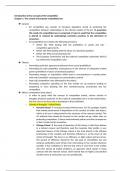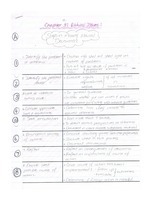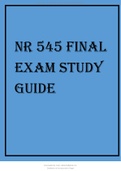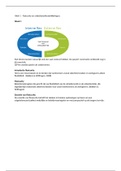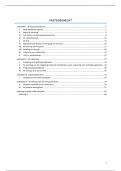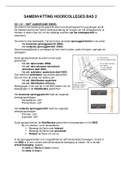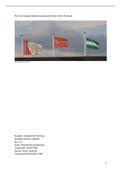PHARMACOLOGY FINAL EXAM STUDY GUIDE-100 POINTS
Schedule Drugs:
Schedule I (C-I): High abuse potential and no accepted medical use (heroin, marijuana,
LSD).
Schedule II (C-II): High abuse potential with severe dependence liability (narcotics,
amphetamines, and barbiturates).
Schedule III (C-III): Less abuse potential than schedule II drugs and moderate
dependence liability (non-barbiturates sedatives, non-amphetamines stimulates, limited
amts of certain narcotics)
Schedule IV (C-IV): Less abuse potential than schedule III and limited dependence
liability (some sedatives, anti-anxiety agents, and non-narcotic analgesics).
Schedule V (C-V): Limited abuse potential. Primarily small amts of narcotics (codeine)
used as antitussives or antidiarrheals. Under Federal Law, limited quantities of certain
schedule V drugs may be purchased without a Rx directly from a pharmacist. The
purchaser must be at least 18 years old and must furnish suitable identification. All such
transactions must be recorded by the dispensing pharmacist.
Antidotes:
Digoxin: Digibind or Dig Fab
Heparin: Protamine Sulfate
Coumadin: Vitamin K
Levothyroxin: Propythiuracil
Opiates: Naloxone (Narcan)
APAP (Tylenol): Mucomyst
Benzodiazapines: Romazicon ( flumazenil)
Atropine: Physostigmine
Barbiturates: activated charcoal ( turbutamide)
Gout: is a disease in which defective metabolism or uric acid causes arthritis, especially in the
smaller bones of the feet, deposition of chalkstones, and episodes of acute pain. Increase in uric
acid levels. It is a risk factor for CAD.
Gout meds block the cause of inflammation in gout: Uric Acid
Goal is diminished uric acid effects
Colchicine: Prevents inflammatory response to uric acid crystals
Zyloprim (allopurinol): prevents uric acid production
Benemid (probenecid): locks uric acid in the urine
Zyloprim and Benemid are nephrotoxic
,APAP (Tylenol):
Antipyretic, non-opioid analgesic does not have the anti-inflammatory effects of the
salicylates or the NSAIDS. Blocks COX3 for fever and pain but not inflammation
(COX2); available OTC. Acts peripherally to limit neurochemicals of pain. APAP can be
extremely toxic. It causes SEVERE LIVER TOXICTY that can lead to death when taken
in high dose and high BP in women with long-term use. Limit daily intake in alcoholics
and elderly. No more than 2,000 mg/day in frail elders and 4,000 mg daily limit in adults.
APAP should be given separely when high doses of opiates are needed; can be given with
Oxycontin or MS Contin (Long-acting morphine) but is is also given between the Q12 hr
doses of these opiates. No bleeding risks but can enhance effects of Coumadin.
Opioids:
Were first derived from the opium plant. Although most narcotics are now synthetically
prepared, their chemical structure resembles that of the original plant alkaloids. All drugs
in this class are similar, in that they occupy specific opioid receptors in the CNS. Their
actions in the body are related to the stimulation of the various opioid receptors they
occupy. Narcotic agonist, narcotic-agonist-antagonist, and narcotic antagonist. Opioid
receptors Mu, Kappa, Delta.
Antibiotics:
Take full course of antibiotics. Not completing the full dose leads to antibiotic resistance.
A back up form of birth control is needed when taking ABX and oral contraceptives. Take
ABX only for a bacterial infection- are not effective against viruses and leads to drug
resistant bacteria. Supra-infection: bacterial resistance that creates infections difficult to
treat and often resistant to multiple drugs. Stop IV ABX if difficulty breathing and
lightheadedness occurs-contact the MD.
Amoxicillin
o Therapeutic Actions/Indications: Tx of infections caused by susceptible strains
bacteria, post-exposure prophylaxis for anthrax, and treatment of H.pylori
infections as part of combination therapy. Extended-spectrum pencillins.
o Nursing Considerations: These drugs are contraindicated in pts with allergies to
penicillin or cephalosporins or other related allergens. Use with caution in pts w/
renal dz. Pregnant or lactating pts should be limited to situations in which the
mother clearly would benefit from the drug. Diarrhea and superinfections may
occur in the infant. Perform C&S tests to ensure that the causative organism is
sensitive to penicillin selected to use. With the emergence of many resistant
strains of bacteria, this has become increasingly important. TAKE ON AN
EMPTY STOMACH but take with water for kidney’s sake. Interacts with birth
control so use barrier contraceptives. People easily develop allergies.
o Adverse Effects: N/V, diarrhea, glossitis, stomatitis, bone marrow suppression,
rash, fever, superinfections, lethargy.
, Cephalosporins
o Similar pharmacologic properties as PCN. Largest ABX class; selection based on
sensitivity. Generic names being with “cef” or “ceph”
o Indications: Gram negative infections and pts who can’t tolerate less expensive
PCNs
o Adverse Effects: similar to PCN. 5-10% allergic to PCN, also allergic to
cephalosporins.
o Examples: cefazolin (Ancef), cefotentan (Cefotan), cefuroxime (Zinacef),
ceftrioxone (Rocephin).
Vancomycin (Vancocin, Vancoled)
o Indications: Interferes with cell wall synthesis in susceptible bacteria. This anti-
infective drug can be used orally or IV to treat life-threatening infections when
less toxic drugs cannot be used. It is used orally as prophylaxis against bacterial
endocarditis in pts who cannot take PCN or Cephalosporins and to treat staph
infections in people who cannot take these groups of drugs.
o Nursing Considerations: Because Vanco may be highly toxic, its use is reserved
for very special situations. When it is the only ABX that is effective against a
specific bacterium, however, the benefits outweigh the risks.
o Adverse Effects: It can cause renal failure, ototoxicity, superinfections, and a
conditions known as “Red Man Syndrome” which is characterized by sudden and
severe hypotension, fever, chills, paresthesias, and erythema of the neck and back.
Ciprofloxacin (Cipro)
o Fluoroquininlone Classification
o Indications: Tx of infections caused by a wide spectrum of gram-negative
bacteria. Tx of respiratory, dermatological, UTI, ear, eye, bone, joint infections,
Tx after anthrax exposure, typhoid fever.
o Nursing Considerations: Contraindicated in preg. Or lactating pts. Use with
caution in the presence of renal dysfunction and seizures. Because so many
resistant strains are emerging, always perform a C&S tests of infected tissue to
determine the exact bacterial cause and sensitivity. These drugs have been
associated with lesions in developing cartilage and therefore are not
recommended for use in children younger than 18 yo.
o Adverse Effects: H/A, dizziness, hypotension, N/V, diarrhea, fever, rash.
Increase risk of developing tendonitis and tendon rupture!
Metronidazole (Flagyl)
o Antiprotozoals
o Indications: Tx of amebiasis, trichomoniasis, giardiasis; acute intestinal
amebiasis, amebic liver abscess, trichomoniasis, acute infections caused by
susceptible strains of anaerobic bacteria, and pre-op and post-op prophylaxis for
pts undergoing colorectal surgery.
o Nursing Considerations: Contraindicated in pregnancy because drug effects on
developing fetal DNA and proteins can cause fetal abnormalities and even death.
Use caution when administering these drugs to pts with CNS disease because of
possible disease exacerbation due to drug effects on the CNS; hepatic disease,
, candidisasis because of the risk of superinfections, and women who are lactating.
NO ALCOHOL FOR UP TO 48 HRS AFTER TREATMENT.
o Adverse effects: H/A, dizziness, ataxia, N/V, metallic taste, diarrhea, darkening
of the urine, dry mouth, fatigue GI distress
Tetracyclines (doxycycline [Vibramycin], minocycline).
o Indications/Actions: Broad range of gram-positive and negative organisms
including Chlamydia, Rickettsiae, and Mycoplasma, H.pylori (peptic ulcer dz),
and acne. Inhibits protein synthesis- prevents cell replication
o Nursing Considerations: Administer with full glass of water (GI irritation), can
yellow teeth forever, do not give to children!!!! Sun sensitive- wear sunscreen; no
dairy products.
o Adverse Effects: Affects vaginal, oral, and intestinal flora leading to
superinfection, N/V, diarrhea.
Tuberculosis:
The bacterium Mycobacterium tuberculosis causes tuberculosis, the leading cause of
death from infectious disease in the world. Tuberculosis can lead to serious damage in the
lungs, the GU tract, bones, and the meninges. Because M. tuberculosis is so slowly
growing, the treatment must be continued for 6 months to 2 years. Using the drugs in
combination helps to decrease the emergence of resistant strains and to affect the bacteria
at various phases during their long and slow life cycle. First-line drugs for treating
tuberculosis are used in combinations of two or more agents until bacterial conversion
occurs or maximum improvement is seen. The first-line drugs for treating tuberculosis are
isoniazid (Nydrazid), rifampin (Rifadin), pyrazinamide (generic), ethambutol
(Myambutol), streptomycin (generic), and rifapentine (Priftin). Increase fluid intake to
prevent toxicity (2-3 L per day). Eliminate alcohol use! Take Vit B6 or foods to prevent
peripheral neuropathy (fortified cereals, baked potato with skin, bananas, lean meats).
Monitor blood glucose. Teach that Rifampin may turn body fluids reddish/orange. Teach
infection control and hygiene! Complete entire course of therapy!!! Mantoux skin test
(ppd) results viewed in 42-78 hours; intradermal; over 10 mm of induration = positive,
chest x-ray, sputum culture; wear N95 respirator!
Drug Name Ethambutol Isoniazid Rifampin Pyrazinamide
Classification Antituberculosis agents T: antituberculars T: antituberculars T: antituberculars
P: rifamycins
Treatment of pulmonary First-line therapy of active Active TB (with Used in combination
Use tuberculosis in TB, in combination with other agents). with other agents in
conjunction with at least other agents. Prevention of Elimination of the treatment of
one other TB in pts exposed to active meningococcal active TB.
antituberculous drug. disease (alone) . carriers
Normal Dosage/ Active: Initial treatment: 300 mg/day (5mg/kg) or 15 600 mg/day or 10 15-30 mg/kg/day as
15-20mg/kg PO daily, mg/kg (up to 900 mg) 2-3 mg/kg/day (up to a single dose. Up to
Max 1600 mg/day times weekly (Vallerand et 600 mg/day) single 60 mg/kg/day has
al., 2013). dose; may also be been used in
given twice isoniazid-resistance



